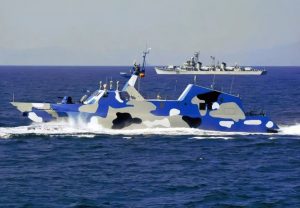Chinese navy boats have reportedly harassed a team of Filipino journalists sailing on a boat in a disputed part of the South China Sea, where Manila and Beijing are currently engaged in a stand-off over the presence of a large flotilla of Chinese vessels.
A news team from the Philippines’ ABS-CBN claims that it was chased by two vessels from the People’s Liberation Army Navy (PLAN), the first time that a Chinese naval ship has been deployed in such a manner.
The confrontation took place on Thursday, as the news team was traveling by boat through the various reefs and shoals in the West Philippine Sea, as Manila refers to its regions of the South China Sea, to report on the plight of Filipino fishermen who have been displaced by Chinese maritime incursions in the region.
According to ABS-CBN, a Chinese Coast Guard (CCG) ship with the designation CCG 5101 appeared on the horizon when the crew was sailing around four nautical miles from Second Thomas Shoal, known as Ayungin Shoal in the Philippines.
The shoal, where the Philippines maintains a rudimentary military presence inside a grounded ship, lies around 168 nautical miles from the coast of the Philippine island of Palawan. This is well within the country’s well 200-nautical-mile Exclusive Economic Zone (EEZ), an internationally recognized area in which it has the exclusive right to exploit oil, gas, fisheries, and other resources.
“It moved closer and closer, and we could see that through our lens,” ABS-CBN reporter Chiara Zambrano said, according to a report in the Filipino press. “After that, it sent a radio communication and in English asked who we were and what we were doing in the area.”
Confronted with the Chinese boat, the Filipino team turned back in the direction of Palawan. After about an hour of being tailed by the ship, it turned back, the media outlet said, after which “two smaller, faster vessels emerged in the horizon, apparently giving chase to the Filipino boat.” It described these vessels as Type 022 Houbei fast attack craft, each of which is typically armed with eight anti-ship missiles.
Described by the state media outlet Global Times as “fast, flexible, stealthy, and powerful,” the boat has been used mostly for coastal defense, but as the publication reported, “the PLA is seemingly exploring its potential to operate beyond that.”
While this kind of intimidating behavior has previously been seen from CCG vessels and those belonging to its predecessor, the Fisheries Law Enforcement Command (FLEC), some experts say the use of navy vessels marks a step up in intensity.
“This is, to my knowledge, unprecedented,” tweeted Greg Poling, director of the Asia Maritime Transparency Initiative at the Center for Strategic and International Studies in Washington, D.C. “I know of no other case of China deploying a PLAN vessel (as opposed to CCG or the old FLEC) to pursue/drive away a civilian ship in the middle of another claimant’s EEZ.”
The incident, which the Defense Department today ordered the military to investigate, comes amid an increasingly tense standoff between the Philippines and China over the deployment of dozens of Chinese vessels in the Spratly Islands, particularly around Whitsun Reef, a low-tide elevation which lies around 175 nautical miles from Palawan.
The Whitsun Reef standoff has been simmering since March 21, when the Philippine government said it had received a report from the Philippine Coast Guard that 220 Chinese ships were spotted at Julian Felipe Reef, as Manila refers to the feature. The standoff has since and sparked a heated exchanges between the two sides and has prompted daily diplomatic protests from Manila, pointing out that the reef lies well within its EEZ.
In a statement on April 5, the Chinese Embassy said “it is completely normal” for Chinese fishing vessels to fish and take shelter at Whitsun Reef, which it described as its “traditional fishing grounds,” claiming that “nobody has the right to make wanton remarks on such activities.” Defense Secretary Delfin Lorenzana responded by describing Beijing’s disregard for international law as “appalling.”
On the same day that the Filipino news team reported being harassed by the Chinese navy, the Philippines Defense Department said it could call for support from the United States, its longstanding treaty ally, for support over the incursion of Chinese vessels.
“As the situation in the West Philippine Sea evolves, we keep all our options open in managing the situation, including leveraging our partnerships with other nations such as the United States,” Defense Department spokesman Arsenio Andolong said in a statement. He added, “We are continuously in talks with the U.S. on the matter of mutual defense.”
Fresh assurances have also been offered from Washington, with Secretary of State Antony Blinken telling his Filipino counterpart Teodoro Locsin Jr. of his nation’s support in a call Thursday. According to the official readout from the U.S. State Department, the two leaders “expressed their shared concerns with the massing of PRC maritime militia vessels in the South China Sea, including at Whitsun Reef, and reiterated their calls on the PRC to abide by the 2016 arbitration ruling issued pursuant to the Law of the Sea Convention.”
Blinken also reaffirmed the applicability of the 1951 U.S.-Philippine Mutual Defense Treaty – the bedrock of the two nations’ alliance – to the South China Sea, an assurance first granted to Manila by his predecessor Mike Pompeo.

































